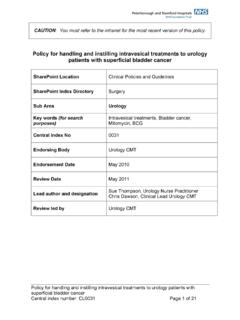Transcription of Guidelines for the Insertion of Suprapubic Catheters
1 Policy for the Central Index 13 October 2010 Page 1 of 15 Guidelines for the Insertion of Suprapubic Catheters Sharepoint Location To be completed by Sharepoint Administrator Sharepoint Index Directory To be completed by Sharepoint Administrator Sub Area To be completed by Sharepoint Administrator Key words (for search purposes) Suprapubic catheter, Ultrasound, Urine retention Central Index No To be completed by Sharepoint Administrator Endorsing Body To be completed by Sharepoint Administrator Endorsement Date To be completed by Sharepoint Administrator Review Date To be completed by Sharepoint Administrator. Under normal circumstances this should be 3ys from initial endorsement. Lead author and designation Chris Dawson, Urology Lead Clinician (if under review) Review led by To be completed by review lead Key Points of document To ensure that Insertion of Suprapubic Catheters (SPC)
2 Takes place in accordance with Trust Guidelines To ensure that the Trust is compliant with NPSA recommendations for SPC Insertion The policy will be revised if national Guidelines are published subsequently Policy for the Central Index 13 October 2010 Page 2 of 15 Index Page Page 1 Frontpage 2 Index Page 3 Background 5 Purpose of Document 5 Keywords 5 Scope 6 Guidelines for the Insertion of SPC 10 References 11 Appendix 1 BAUS Dataset Policy for the Central Index 13 October 2010 Page 3 of 15 Background The NPSA Report 2009/RRR005 supporting information documentation provides a good background to the rationale behind Suprapubic catheter Insertion and this is reproduced verbatim below. It is well known that Suprapubic catheterization (SPC) can cause patient harm and the Trust is now required to produce Guidelines to minimize this risk.
3 Guidelines are awaited from the British Association of Urological Surgeons (BAUS) but at the time of writing (28 September 2010) these have not been published. The National Reporting and Learning Service has produced 6 questions, which it suggests should be answered by any practitioner who is considering placing a Suprapubic catheter. These questions, and the suggested responses are reproduced below Policy for the Central Index 13 October 2010 Page 4 of 15 Finally, the Rapid Response report suggests the following actions by all Trusts Policy for the Central Index 13 October 2010 Page 5 of 15 Purpose of the document To set out Trust Guidelines for the Insertion of Suprapubic Catheters Key words Suprapubic catheter, Ultrasound, Urine retention Scope In principle these Guidelines would apply to all medical and nursing staff, and certainly all staff should be made aware of them once they have been agreed.
4 However in practice only the Urology team and Gynaecology teams have in the past been responsible for placing Suprapubic Catheters and this situation is likely to continue. It has therefore been agreed that only appropriately trained members of the Urology or Gynaecology department should perform this procedure. Policy for the Central Index 13 October 2010 Page 6 of 15 Guidelines for SPC Placement Does the procedure need to be done? Patient MUST be confirmed to be in retention This begins with the clinical history and examination but retention of urine MUST be confirmed by using the portable ultrasound machine to confirm that the bladder is sufficiently distended to allow SPC catheterization to proceed (this will depend in part upon the experience of the person attempting SPC placement).
5 Consideration of catheterization by the urethral route. In most cases this will already have been attempted and failed (because of stricture, BPH etc.). In cases of chronic retention of urine the Suprapubic route may be preferred over the urethral route. The reasons for attempting SPC and preferment over the urethral route should be clearly recorded in the patient s notes Am I competent to do this? Only appropriately trained members of the Urology or Gynaecology departments will perform this procedure. This will require formal training to include o Familiarization with the equipment required and signed competency to that effect o The procedure itself o Qualified supervision until competence is demonstrated Competence will be recorded and logged with the SPC Lead (Chris Dawson) Does this procedure need to be done now?
6 The vast majority of SPC placements are performed for acute urinary retention where the urethral route has failed, and therefore the procedure does need to done It is suggested that where a SPC is considered outside of the Urology/Gynaecology setting that the practitioner concerned asks for advice from the Urology SpR on call or, out of hours, from the Gynaecology SpR on call Is this procedure right for the patient? Absolute Contraindications o Bladder is impalpable / not visible on portable ultrasound Policy for the Central Index 13 October 2010 Page 7 of 15 o Pregnancy o Gross or morbid obesity Relative contraindications o Uncontrolled coagulopathy o Paediatric cases Consultant Urologist input required o Prior abdominal or pelvic surgery (risk of adhesions)
7 Urology/Gynaecology Input required as open procedure may be necessary SPC placement Assess for retention and confirm bladder visualized on Ultrasound abandon procedure if any doubt and seek Consultant advice Consider Urethral route FIRST, but do not persist in attempts at Urethral catheterization if it is clear that catheter will not pass easily via urethra into bladder Explain procedure to patient Assess for absolute / relative contraindications Ensure bladder portable ultrasound to hand Use Suprapubic catheter set appropriate to signed competency (BARDTM preferred1) Lie patient prone and clean abdominal wall below umbilicus with betadine skin preparation Identify point 2 finger breadths above symphysis pubis in midline and infiltrate skin with 1% Lignocaine + 1/200000 Adrenaline Infiltrate below skin to include the fascia Using this needle CONFIRM that urine can be aspirated from bladder the needle should be positioned at 90 degrees to the skin surface which may not in fact be directly vertical in a distended bladder.
8 Attempting to aspirate directly vertically may lead the needle to enter into the retropubic space rather than going into the bladder. If urine CANNOT be aspirated from the bladder the procedure should be abandoned at this point and the patient assessed with consideration given to an 1 The technique described below relates to the BARDTM SPC other sets may require a slightly different technique but the operator must still confirm full bladder by use of ultrasound Policy for the Central Index 13 October 2010 Page 8 of 15 open SPC placement Once the skin and underlying tissues are anaesthetized a 1 cm incision is made in the skin and deepened through the subcutaneous fat. The fascia is also incised it is critical that this fascial incision is wide enough to allow subsequent placement of the Suprapubic catheter trocar to prevent too much force being used which can lead to complications At this point it is helpful (though not mandatory) to confirm with the syringe/needle that Urine can still be aspirated from the bladder.
9 This step also reminds the practitioner of the approach angle that the trocar needs to take to enter the bladder and may prevent (for example) the trocar/sheath entering the retropubic space in error The trocar within its sheath should be inspected to make sure that it can be removed easily from the sheath The trocar/sheath is then inserted into the bladder. The practitioner should keep one hand on the shaft of the trocar/sheath about 2-5 cm from the tip and use a corkscrew motion to allow the trocar to pass into the bladder. It should not be necessary to use excessive force and indeed if this is the case it is likely that the incision in the fascia needs to be extended Once the trocar tip enters the bladder a flashback of urine is common. It is crucial that the trocar/sheath is advanced a further 1cm to ensure that the sheath itself (and not just the trocar tip) is inside the bladder.
10 At this point the trocar is removed from the sheath and the catheter passed down the lumen of the sheath all the way into the bladder. The tear-off strip is removed from the sheath while ensuring that the catheter is held within the bladder, and the sheath is removed. The balloon on the catheter is inflated. For extra security the catheter may be sutured to the skin with a silk suture which may be useful to help close the skin incision around the catheter and minimize bleeding Policy for the Central Index 13 October 2010 Page 9 of 15 The procedure is fully documented in the patient s notes Monitoring for complications and after care If clear urine is drained then it is unlikely that complications will ensue The passage of urine that is faecally stained should be noted and further investigations performed to exclude bowel perforation The patient should be monitored for abdominal symptoms and/or told to report these if they should occur Sometimes rapid decompression of a chronic urinary retention can lead to haematuria.




